Young minds in science: the European Union Contest for Young Scientists 2010 Inspire article
Marlene Rau reports on the 22nd European Union Contest for Young Scientists (EUCYS).
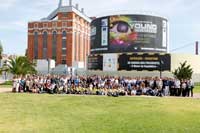
host to the 2010 contest
Image courtesy of the
Portuguese Youth Foundation,
Host Organiser of EUCYS 2010
A sunny afternoon in Lisbon – boatmen set sail from the shores of the River Tejo, evoking thoughts of the many great explorers that have ventured forth from here to discover uncharted territories. It is a late September day in 2010, and in the nearby Electricity Museum, 124 vibrant minds from 37 countries are presenting their own ventures into science.
The hall is abuzz with young contestants (aged 14-21) who have travelled from across Europe and beyond. We, the 18 members of the international jury, have a tough time choosing among these excellent projects: how can you compare the design of a flat-packed Christmas tree with behavioural studies of birds; a collection of Moroccan folk tales with a dig for dinosaur bones; face-recognition algorithms with improved methods for wastewater treatment; a gadget for identifying fraudulent drycleaners with a study on whether Internet addiction causes brain lesions?

the Discoveries in Lisbon
Image courtesy of Carlos Paes;
image source: Wikimedia
Commons
The European Union suggests a good recipe for creating a winning project: “Choose a subject that interests and inspires you (the idea must of course be an original one). Add a little curiosity and know-how, a touch of perseverance and obstinacy, some advice from specialists, a good pinch of ingenuity, a large measure of a critical mind, enthusiasm and an enterprising spirit and, above all, the best part of your imagination.”
While the jury is locked in fierce discussions behind closed doors, the contestants explore Lisbon and its surroundings: they dance the quadrille with costumed guides in the baroque palace in Mafra; dine in the adjoining monastery, served by soldiers training for conflict zones; listen to talks on biodiversity and patenting; and satisfy their curiosity in the ‘Explore’ room at the Park of Nations Knowledge Pavilion: can you touch a tornado? Are all shadows just black and white?
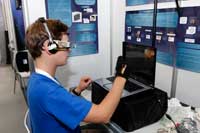
demonstrates his 3D user
interface
Image courtesy of the
Portuguese Youth Foundation,
Host Organiser of EUCYS 2010
And of course, there is much to explore inside the Electricity Museum, too: during the breaks, students peruse the museum’s marvellous interactive exhibition.
Finally, the 26 prizes are allocated. First-prize winners are Miroslav Rapcak and David Pegrimek from the Czech Republic, who computer-predicted a complete phase diagram of CO2 nanoclusters; Márton Balassi and Dávid Horváth from Hungary, who developed a computer simulation of ecosystems for the classroom, which can also be used for risk assessment; and Lukasz Sokolowski from Poland, who studied the foraging strategy of the ant Formica cinerea.
The ten main prizes sponsored by the European Union are complemented by a range of prestigious special prizes, including those offered by EIROforumw1: seven one-week stays at one of its member organisations, each of which is awarded to a worthy participant who would profit from a visit to that institute.
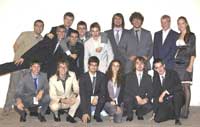
Union prizes at EUCYS 2010
© European Communities,
1995-2010
Volha Shumskaya (aged 17) from Belarus will travel to CERNw2, the European Organization for Nuclear Research in Geneva, Switzerland, where enormous amounts of data are generated and processed every day. This enthusiastic mathematician has studied the extrema of least common multiples and greatest common divisors for sequences of numbers. Janis Smits (aged 18) from Latvia is the proud winner of a visit to the fusion reactor at EFDA-JETw3 in Culham, UK. Like his host organisation, Janis is concerned with improving energy generation, and has developed a light thin-layer lithium iron phosphate battery to propel his bicycle.
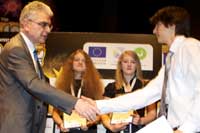
general of EFDA-JET and
chairman of EIROforum,
presents the ILL prize to
Radko Kotev. In the
background, CERN prize
winner Volha Shumskaya
(left) and ESA prize winner
Vladimíra Bejdová (right)
© European Communities,
1995-2010
Vladimíra Bejdová (aged 19) from the Slovak Republic will visit the European Space Agencyw4. The space enthusiast has discovered and analysed a new binary star in the Andromeda constellation using a small telescope.
The biologist among the EIROforum prize winners is Raghd Rostom (aged 19) from the UK. Her use of cells from embryonic chick bones as a model for osteogenic versus chondrogenic differentiation in stem cells won her a visit to the European Molecular Biology Laboratoryw5 in Heidelberg, Germany. Young astronomer Pavel Fadeev (aged 19) from Israel will travel to the European Southern Observatory’sw6 telescopes in Chile, where he can discuss his unique catalogue of 270 extragalactic star-forming regions with professional colleagues.
Maths enthusiast Radko Kotev (aged 18) from Bulgaria was awarded a trip to the Institut Laue-Langevin (ILL)w7 for finding a new solution to the geometrical Apollonius problem – constructing a circle that is tangential to three given circles. He will be joined at the campus of ILL and the European Synchroton Radiation Facility (ESRF)w8 in Grenoble, France, by ESRF prize winner Sebastian Cincelli (aged 19) from Italy, a young engineer who designed ‘social’ robots on wheels for exploring uncharted areas.
Read about these and all other award winners and their projects on the EUCYS 2010 websitew9.
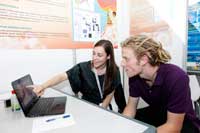
ideas
Image courtesy of the
Portuguese Youth Foundation,
Host Organiser of EUCYS 2010
Apart from explaining their projects to the jury, the contestants also have the chance to present their work to the general public. Over 3000 students from schools across Portugal visit the EUCYS stands and marvel at their peers’ ingenuous ideas. This may lay the foundation for the next generation of EUCYS contestants. The event does have an impact, as João Amaral (aged 21) is well aware – one of the many Portuguese student helpers, he was himself a contestant in EUCYS 2007.
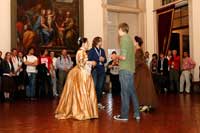
Image courtesy of the
Portuguese Youth Foundation,
Host Organiser of EUCYS 2010
These helpers not only solve any minor or major problems the contestants have, and guide them through their social programme, but this year also give their own set of awards at the final ceremony, in 14 categories such as ‘the funniest’, ‘the most enthusiastic’ or ‘the most Portuguese’ project (which goes to the Brazilian contestant).
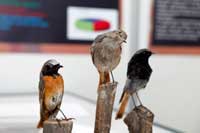
Republic analysed the
habitat preferences of black
(right) and common (left)
redstarts. Unlike the males,
females (middle) are very
similar in both species
Image courtesy of the
Portuguese Youth Foundation,
Host Organiser of EUCYS 2010
The impact of EUCYS is something Maximos Tsalas from EFDA-JET can vouch for, too – together with Claus Habfast from ESRF, he offered an enjoyable evening of lectures on energy to the students, demystifying the concept of fusion energy, to coincide with the theme of the Electricity Museumw10.
“EIROforum has been a part of this contest for many years, and last year’s winner is currently visiting EFDA-JET, working with us,” says Maximos. “We are always looking for bright minds, so we offer selected participants the opportunity to visit EIROforum organisations.”
And what is the contestants’ verdict? “I’m certain we will carry these memories with us for the rest of our lives: to meet other young scientists, to understand their projects and to share some ideas are our main goals during these days,” explains Guoda Radaviciute from Lithuania.
EUCYS is a great experience for everyone involved – and we are already looking forward to EUCYS 2011 in Helsinki, Finlandw11.
Web References
- w1 – For more information about EIROforum, see: www.eiroforum.org
- w2 – To learn more about CERN, see: www.cern.ch
- w3 – More information about EFDA-JET is available here: www.jet.efda.org
- w4 – To learn more about the European Space Agency, visit: www.esa.int
- w5 – For more details about the European Molecular Biology Laboratory, see: www.embl.org
- w6 – More information about the European Southern Observatory is available here: www.eso.org
- w7 – For more information about the Institut Laue-Langevin, see: www.ill.eu
- w8 – To learn more about the European Synchroton Radiation Facility, visit: www.esrf.eu
- w9 – The EUCYS 2010 website includes information about all participants, their projects and the contest, along with many pictures and videos:
- Further movies are available on the EUCYS YouTube channel. See: www.youtube.com/user/EUCYS2010
- w10 – The slides of Claus Habfast’s and Maximos Tsalas’s lectures can be downloaded here.
- w11 – Learn more about the 2011 edition of EUCYS in Helsinki and enter their slogan competition. See: http://eucys2011.tek.fi
Resources
- For more information on EUCYS, see the European Commission website: http://ec.europa.eu/research/youngscientists
- To find out more about the national competitions and to contact your national organiser, see: http://ec.europa.eu/research/youngscientists (under ‘Who is involved?’)
- Read about how last year’s winners enjoyed their EIROforum visits:
- Williams C (2011) Young scientists at the cutting edge. Science in School 18: 10-12.
- Learn more about EIROforum and the research performed at its organisations here:
- EIROforum (2010) EIROforum: introducing the publisher of Science in School. Science in School 15: 8-17.
Institutions






